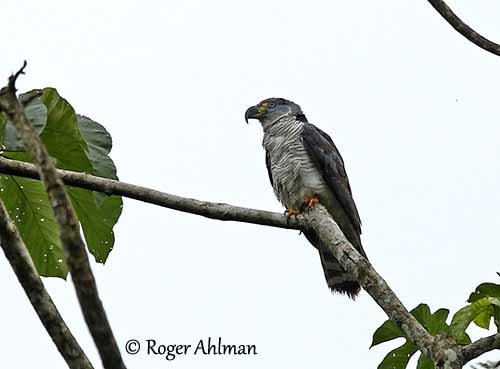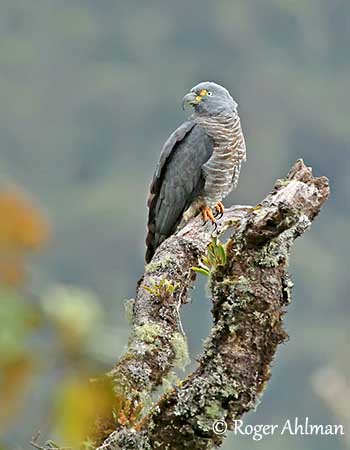
Fr: Milan bec-en-croc, Bec-en-croc de Temminck
Ang: Hook-billed Kite
All: Langschnabelweih
Esp: Milano picogarfio, Caracolero Piquiganchudo, Milano Piquiganchudo
Ita: Nibbio beccouncinato
Nd: Langsnavelwouw
Sd: Kroknäbbsglada
Photographer:
Roger Ahlman
Pbase Galleries Peru and Ecuador
Text by Nicole Bouglouan
Sources:
HANDBOOK OF THE BIRDS OF THE WORLD Vol 2 by Josep del Hoyo-Andrew Elliot-Jordi Sargatal - Lynx Edicions - ISBN: 8487334156
HAWKS, EAGLES AND FALCONS OF NORTH AMERICA by Paul A. Johnsgard - Smithsonian Institution Press - ISBN: 1560989467
A GUIDE TO THE BIRDS OF MEXICO AND NORTHERN CENTRAL AMERICA by Steve N. G. Howell, Sophie Webb - Oxford University Press - ISBN: 0198540124
A GUIDE TO THE BIRDS OF COLOMBIA by Steven L. Hilty and William L. Brown - Princeton University Press – ISBN 069108372X
Global Raptor Information Network - Working to Conserve Birds of Prey in nature
What Bird-The ultimate Bird Guide (Mitchell Waite)
SORA Searchable Ornithological Research Archive (Blair O. Wolf)
First nesting of dark-morph Hook-billed Kite in the United States
Belize raptor – Research Institute - Hook-billed Kite Project
Feeding Habits and Bill Polymorphism in Hook-Billed Kites
The Texas Breeding Bird Atlas - HOOK-BILLED KITE
Hook-billed Kite
Chondrohierax uncinatus
Accipitriformes Order – Accipitridae Family
INTRODUCTION:
The Hook-billed Kite is the only member of the genus Chondrohierax. It is known for its diet consisting mainly of arboreal snails, taken while climbing in trees, walking about in upper branches and looking for tree snails. This species occurs usually in the canopy, and spends most of its time on its favourite perch. On the ground just below, there is a variable amount of empty snail shells. The bill size varies among birds, and smaller snails are taken by smaller-billed kites.
The Hook-billed Kite has wide range from Mexico through Central America, to the northern half of South America. It is threatened by deforestation throughout the range, but the species is currently evaluated as Least Concern.

DESCRIPTION OF THE BIRD:
Biometrics:
Length: 39-51 cm
Wingspan: 78-98 cm
Weight: M: 251-257 g – F: 240-300 g
The Hook-billed Kite has broad wings pinched in at base and broad-fingered “hand”.
The adult male of the typical grey-bellied morph has bluish-grey upperparts becoming more fuscous in worn plumage. The flight feathers are barred grey and black. The longish tail is black and narrowly tipped white, and there are two broad pale greyish bars.
Chin and throat are dark lead-grey. The underparts are grey with fine white barring on breast, whereas belly and flanks are variably barred white of cinnamon-brown. The undertail-coverts are white to cinnamon-buff. The tail is black with two broad whitish bands. The basal band is often covered by the tail-coverts.
On the underwing, coverts and axillaries are deep dark grey with white or buff barring. The flight feathers are barred grey and white.
On the head, head sides, crown, nape and ear-coverts are dark grey. There is a bright yellow-orange patch of bare skin above the pale green lores.
The hooked bill has black upper mandible whereas the lower one is pale yellow-green. Cere and nape are greenish-yellow. The eyes are white, surrounded by pale green eyering. Tarsi and feet are orange-yellow with black claws.
Variations in bill size are reported throughout the range, with large bills twice as large as small ones, in both sexes and all ages.
The female is mostly brown on the upperparts, with grey head and head sides, and rufous nuchal collar. The underparts, and especially the breast, are rusty to brown with narrow white bars. The bare parts are like in male.
The juvenile is dark brown above and creamy-white on the underparts. It has white nuchal collar and the tail shows 3-4 bars.
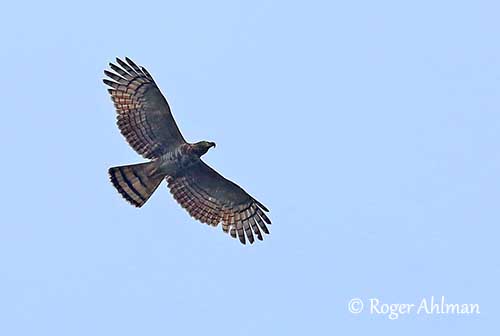
There is a melanistic morph with dark grey to deep rufous-black plumage overall. The tail is black with narrow white terminal band, and 1-2 broad white bars. The bare parts are similar to typical morph.
The juvenile in dark morph is all-black with whitish bars in tail.
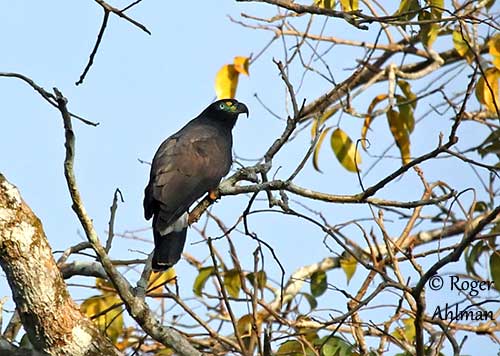
SUBSPECIES AND RANGE:
The Hook-billed Kite has two subspecies.
C.u. mirus is found on Grenada in the Lesser Antilles. This race is smaller with less variable plumage and bill size. The dark morph is lacking.
This race is seriously Endangered, due to habitat loss and introduced snails which are too big for this raptor.
C.u. uncinatus (described above and displayed) is found from W Mexico and extreme S USA (Texas), S through Central America, Trinidad, the Guianas and Brazil to E Peru and E Bolivia, Paraguay and N Argentina.
HABITAT:
The Hook-billed Kite is found in the rainforest where it occurs in dense undergrowth and lower canopy, swampy areas, second growth and gallery woodland, but it also frequents clearings, forest edges, and disturbed forest.
It can be seen from sea-level up to more than 3000 metres of elevation, and occurs regularly at 2700 metres. However, it is mainly found below 1500 metres, and even below 900 metres in Mexico.
It nests in trees in tropical, subtropical and sometimes temperate forests, and generally in a wide variety of forest habitat.
On Grenada, the endemic race “mirus” occurs in xeric woodlands in the southern part of the island, where land snails are common in flat areas. It breeds in deciduous and evergreen montane rainforests.
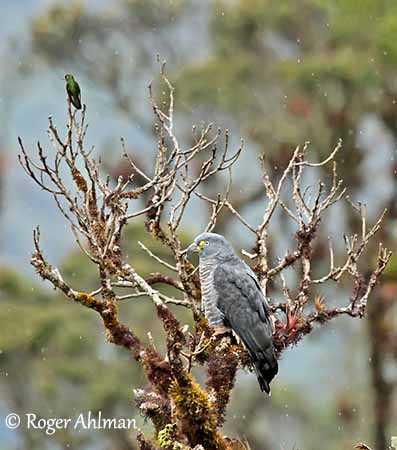
Note the Flame-throated Sunangel
on the top left
CALLS AND SONGS: SOUNDS BY XENO-CANTO
The Hook-billed Kite utters a rapid, musical “wi-i-i-i-i-i-i-uh” when perched or in flight. Other sounds such as soft “hu-ey”, harsh chattering rattle “hay-tetetete” in territorial defence, and screaming notes in alarm can be heard. It also produces a very musical 2-3 notes whistle similar to notes of an oriole of family Icteridae.
The Hook-billed Kite is noisy and vocal during the breeding season, especially during the courtship displays and around the nest.
BEHAVIOUR IN THE WILD:
The Hook-billed Kite feeds primarily on tree snails of various species, but it occasionally takes some terrestrial and aquatic snails. It forages by climbing through the vegetation, often more like a Psittacidae than a raptor.
It snatches the snail with the bill and flies to a tree with the food. The snail is held in the left foot and braced against a branch. The bird inserts the tip of its bill into the open side of the shell, in order to break progressively each whorl. Then, the snail is removed from the shell and swallowed whole.
This feeding technique differs from that of the Snail Kite (see the card).
It also takes some reptiles, frogs, freshwater crabs and insects, mainly caterpillars. Predation of birds is very rare and occasional.
The different bill sizes allow the kites to feed on different snails. But the race “mirus” feeds on the only snail available on Grenada, and does not show dimorphism in bill size.
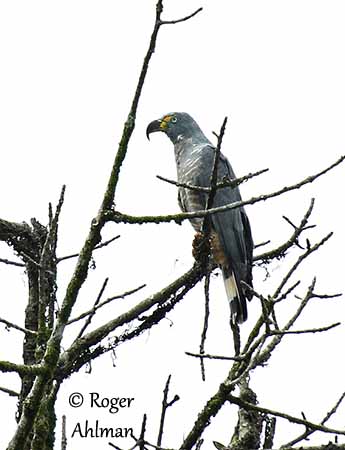
The Hook-billed Kite hunts by perching in the lower canopy of the dense understorey. It may hop between branches, or even hanging upside-down to seize the snail. It also hunts by flying in circles above trees or ground and drops down onto the prey. During the nesting period, it hunts all the day to feed the chicks.
The Hook-billed Kite is usually found alone or in small groups of 2-3 individuals. But several kites may gather at abundant food sources, in areas where snails are concentrated.
During the breeding season, between May and November, the Hook-billed Kite performs typical aerial displays with the birds circling together low above the trees. They dive at each other while calling. But this behaviour is not currently well known. Both parents share the nesting duties, except the incubation mainly performed by the female.
The Hook-billed Kite is probably sedentary in its range, although some movements are reported and probably related to snail availability. However, records of flocks of 30 to 120 individuals in Belize may suggest migration, with autumn and spring movements. Altitudinal movements are reported too, both in the Andes and Central America.
The Hook-billed Kite soars on thermals and updrafts. It glides with slightly bowed wings. The flight is performed rather slow and floppy, with deep wingbeats. In typical flight pattern, the bird makes rapid flapping interspersed with glides.
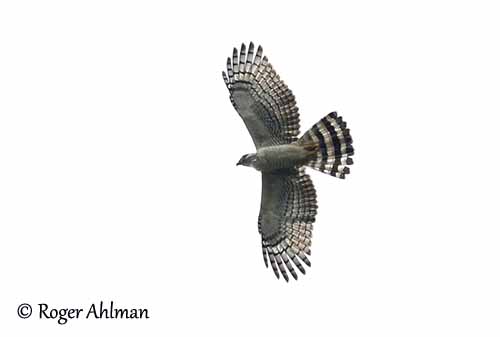
REPRODUCTION OF THIS SPECIES:
The breeding season occurs between May and November, with the egg-laying between June and September for the race “mirus” on Grenada.
Elsewhere, the season varies depending on the range. The eggs usually hatch at the beginning of the rainy season, when snails are most abundant.
The Hook-billed Kite nests in trees, between 15 and 25 metres above the ground, sometimes lower, at about 5-7 metres. The nest is small and so flimsy that eggs and chicks can be seen from below. It is made with twigs and unlined. This shallow platform is placed in a fork in tree, or in horizontal branch farther out, in mature and older trees.
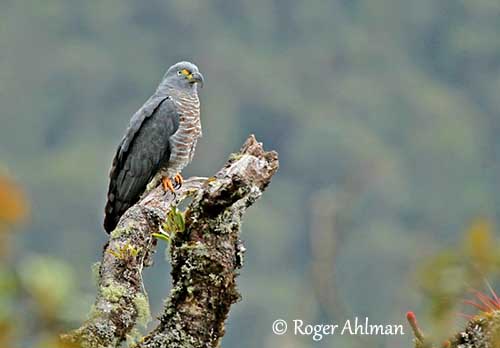
The female lays 1-3 (often 2) dull white eggs with dark brown markings. The incubation lasts 34-35 days, shared by both parents, but the female does most of work. The male provides and brings food to the female and occasionally feeds the chicks with snails.
The young fledge between 24 and 38 days after hatching, depending on the range (38-39 days in Argentina and 24-33 days in Guatemala). They fledge in early to middle rainy season, when snails are abundant. But they still depend on adults for food for some weeks.
From an observation by Smith (1982), six nests were found within 5 kilometres of each other, suggesting moderate social dispersion.
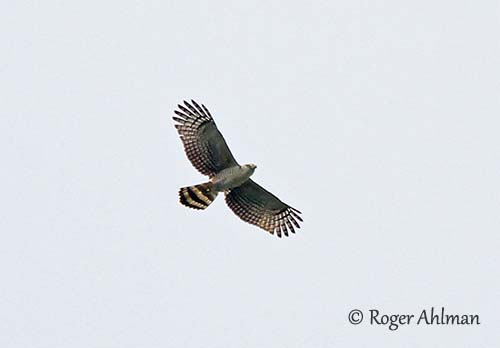
PROTECTION / THREATS / STATUS:
The Hook-billed Kite is widespread throughout its range, but it often appears to be uncommon.
Local decreases are reported in several parts of the range in W Colombia, W Ecuador, E Brazil and NE Argentina. But this species is sometimes difficult to find in the foliage. It is locally common in Venezuela, Surinam and Guatemala, and rare in Paraguay. Texas was colonized in recent decades, and 10-20 pairs were present by mid-1980s.
The race “mirus” from Grenada is classified as Endangered, with a stable population of only 50-75 individuals in 2000/2006, but it is still threatened by forest-habitat loss.
But globally, the Hook-billed Kite is currently evaluated as Least Concern, with a population estimated at 200,000 mature individuals.
